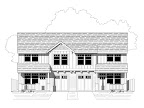Tuesday, December 15, 2015
Efficiency by Design - Floors
What's the difference between a floor and a ceiling? Not much. If it's unfinished below, it's a floor. If it's unfinished above, it's a ceiling. If it's finished on both sides it's a floor and a ceiling. With the exception of trusses (which we'll discuss later in Roofs), both are built very similarly.
One of the most common ways to build a floor is with beams and joists. Joists span between bearing walls on the outside and mid bearing beam lines. Joists are typically spaced at 16" on center though depending on the subfloor used, 24" is perfectly fine. If bonus room trusses are spaced at 24" o.c., there's no reason that the rest of the floor joists can't follow suit.
But subfloor is not the only determining factor in joist spacing. The size of the joists matters as well. If you are using 2x12 joists (which is fairly common) they can be used for 16' spans at 16" o.c. But if your span is only 14' long, those same joists can be spaced at 24" o.c. with no loss of performance.
Of course it's most beneficial if all of the joists have the same spacing. You don't want a section of 16" o.c. with another run of 24" o.c. and then back to 16" o.c. Trimming subfloor to match these changes takes time. An astute designer will make sure that the spacings break at even increments.
Depending on your workflow you might consider gluing and screwing the subfloor down. This practice can help take longer spans and make them more rigid allowing the joists to eke out anywhere from a few extra inches to an extra foot with no performance loss. Why overspan the joists like this? For one, you may be able to eliminate a beam that would otherwise be used to assist the joists only.
On the other hand, adding in a beam on a longer span may allow that one area to bump up to 24" o.c. spacing, allowing the entire floor to be uniform. It all has to do with the layout and having a designer look it over.
What about a case where the upper floor stops short of the lower floor? Designers often throw in a beam thinking that the load needs to be directed straight down. But it is not too difficult to calculate the joists to handle that perpendicular load. If it's not too great a load and close enough to the end, the beam can be removed and the joists can do the work. They would have been doing it partly anyway but they still would have had more tolerance for extra load.
We haven't discussed the other type of floor system, post and beam. This is very popular in the Pacific NW and limited in other parts of the country. Post and beam consists of 4x8 beams at 32" or 48" apart and set on footings that area 8' apart. These types of floors are heartily overbuilt. It makes for a very sturdy floor but this system can be optimized and still deliver sturdy performance.
The first consideration is the span of the beams. They are often 8' apart. If they are 4x8 @ 32" o.c. then they are quite capable of spanning 12' with very satisfactory performance. If 4x10 beams are used, they can span over 14' and 4x12 beams can surpass 16'. "But what of the extra load on each footing?", you may ask. The typical footing in this set up is an 18" diameter footing. These footings are big enough to handle 2650 lbs each. the 4x12 running 16' long has a load of less than 1200 on each end meaning the 18" diameter footing is still more than adequate.
Efficiency by Design can help you find these redundancies and save you time and money on your building process. Begin the conversation with an email or phone call. We'll handle the rest.
Subscribe to:
Post Comments (Atom)







No comments:
Post a Comment